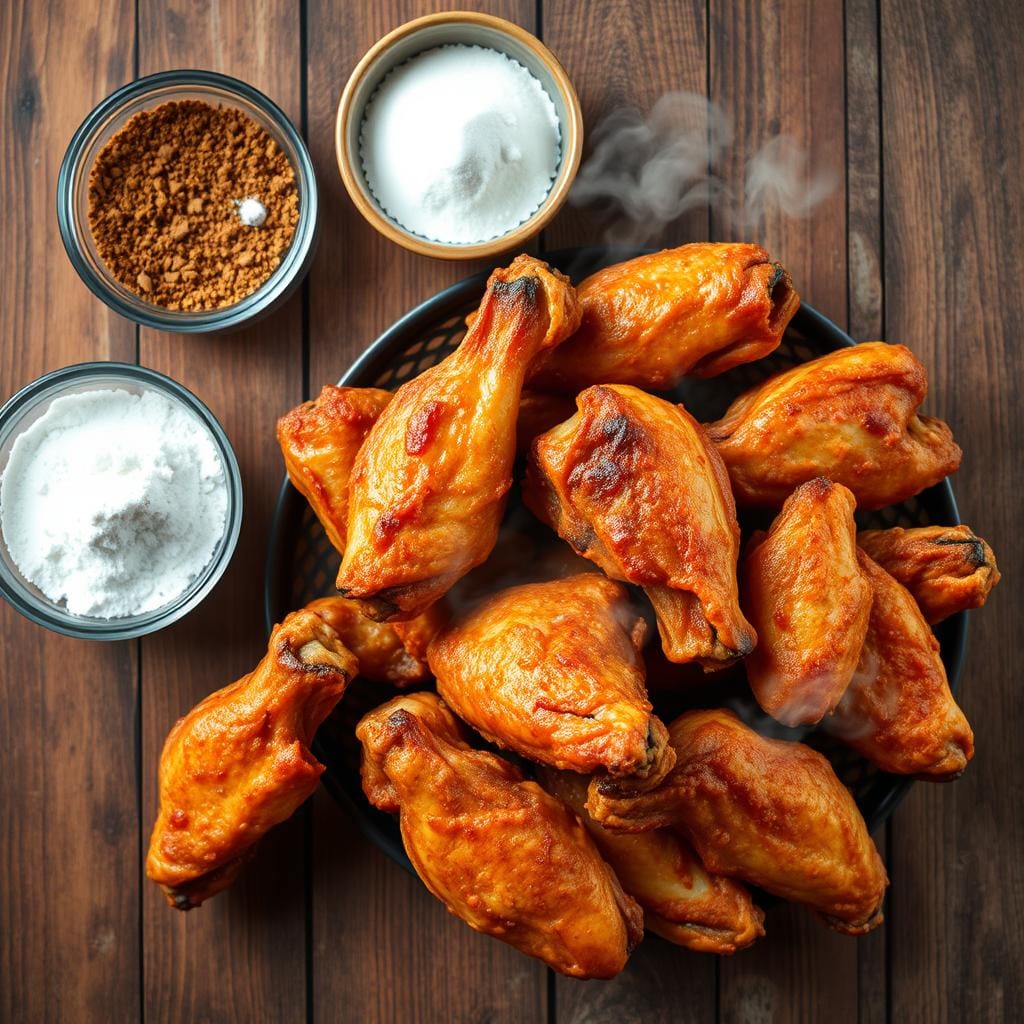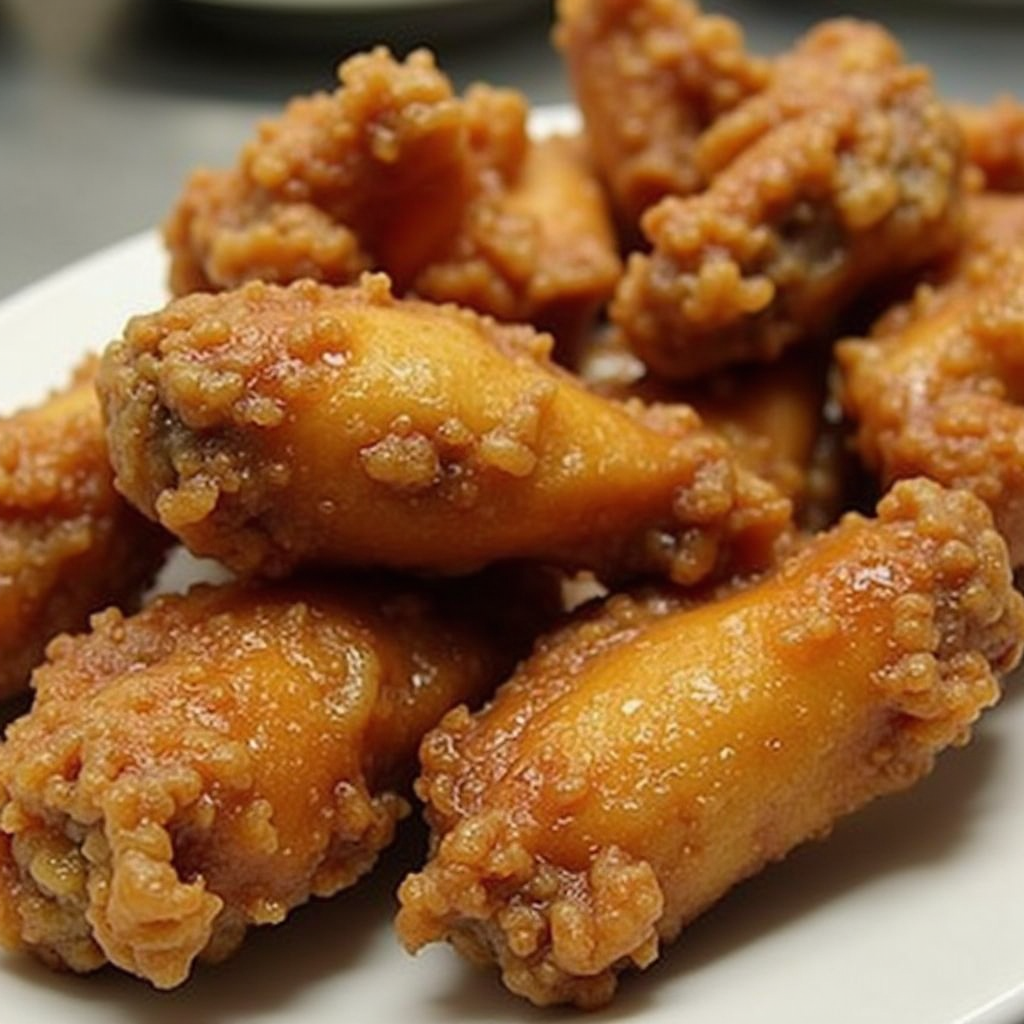Every home cook has faced the disappointment of serving soggy chicken wings. I remember my first Super Bowl party, where my wings were limp and disappointing. But, there’s hope for wing lovers everywhere – a secret ingredient that makes wings crispy and delicious.
Finding the perfect crispy wings isn’t just about cooking. It’s about understanding the science behind that irresistible crunch. Both professional chefs and home cooks have been searching for this magic method.
Imagine biting into a chicken wing that’s so crisp it makes a satisfying crackle. The exterior is golden-brown, locking in all the flavor. This isn’t just a dream – it’s achievable with the right secret ingredient and technique.
Table of Contents

Key Takeaways
- Crispy wings require more than just standard cooking methods
- The right ingredient can transform wing texture dramatically
- Professional cooking techniques are accessible to home cooks
- Achieving restaurant-quality wings is possible with scientific understanding
- Texture is as important as flavor in wing preparation
The Science Behind Perfect Crispy Wings
Explore the world of wing science to learn the secrets of crispy skin. Achieving the ultimate wing experience requires chemistry, physics, and culinary skill. It’s more than just cooking.

Understanding Protein and Fat Content
Wing science shows that protein and fat are key for crispy texture. Chicken wings have a special mix of proteins and fats. When cooked, these interact to create crispy edges.
- Chicken wing protein helps form the crispy exterior
- Fat content contributes to flavor and texture development
- Proper protein denaturation leads to improved crispiness
The Role of Moisture in Crispiness
Moisture is the enemy of crispy skin. Removing surface moisture is crucial. Patting your wings dry before cooking helps achieve that restaurant-quality crisp.
“The key to crispy wings is eliminating moisture before cooking” – Professional Chef Technique
Temperature Control Basics
Temperature control is vital in wing preparation. Different temperatures trigger chemical reactions that affect texture. High heat quickly renders fat, while controlled temperatures prevent burning and ensure even crisp.
| Cooking Method | Ideal Temperature | Crispiness Level |
|---|---|---|
| Deep Frying | 375°F | Extremely Crisp |
| Oven Baking | 425°F | Moderately Crisp |
| Air Frying | 400°F | Crisp with Less Oil |
Grasping these scientific principles turns wing cooking into a precise art. Each method brings you closer to that perfect crispy skin every wing lover dreams of.
Baking Powder: The Game-Changing Secret Ingredient

Discovering the secret to crispy wings isn’t magic—it’s science! Baking powder is the unexpected hero. It turns ordinary chicken wings into restaurant-quality delights.
Baking powder works its magic through a fascinating chemical reaction. It breaks down proteins and creates microscopic bubbles. This enhances the surface texture of your wings. The alkaline nature of baking powder also helps with browning, giving your wings that golden-brown crispiness.
“The difference between good wings and great wings is often just a light dusting of baking powder.” – Professional Chef Recommendation
How Baking Powder Creates Crispy Perfection
- Raises the skin’s pH level
- Breaks down protein structures
- Increases surface area for browning
- Helps moisture evaporate faster
When using baking powder for crispy wings, follow these pro tips:
- Use aluminum-free baking powder
- Apply a thin, even layer
- Let wings rest uncovered in the refrigerator
- Cook at high temperatures
| Baking Powder Type | Crispiness Rating | Recommended Use |
|---|---|---|
| Aluminum-free | ★★★★★ | Best for wing recipes |
| Standard | ★★★ | Acceptable alternative |
| Homemade Mix | ★★★★ | Custom seasoning option |
Pro Tip: Always pat wings dry before applying baking powder. This maximizes crispiness and ensures even coating.
What is the Secret Ingredient to Crispy Wings?
To make chicken wings crispy, you need to know some cool kitchen tricks. The key ingredient is baking powder.
Baking powder is magic. It changes the wings through special chemical reactions. This makes them crunchy every time.
Chemical Reactions During Cooking
Baking powder does something amazing when it meets chicken skin. It breaks down proteins, making the skin super crispy and golden.
- Proteins denature at high temperatures
- Moisture gets pushed to the surface
- Skin develops microscopic bubbles
pH Levels and Crispiness
Getting the right pH level is key for perfect wings. Baking powder makes the skin more alkaline. This helps it brown faster and get those crispy edges.
“Crispiness is 50% science, 50% technique” – Professional Chef
Application Techniques
Using baking powder right is important. Sprinkle it evenly over the wings. Make sure it covers them all without clumping.
- Pat wings completely dry
- Dust with baking powder
- Refrigerate for minimum 1 hour
- Cook at high temperature
Learning these tricks will make your wings amazing.
Dry Brining: Essential Pre-Cooking Step
Turning ordinary chicken wings into crispy delights starts with dry brining. This method boosts their texture and flavor. It makes your wings taste like they came from a restaurant.
Dry brining pulls moisture out of the chicken’s skin. It also seasons the meat deeply. The process is easy and needs just a few ingredients.
“Dry brining is like a magic trick that turns average wings into extraordinary crispy masterpieces.” – Professional Chef
- Sprinkle kosher salt evenly over clean, dry wings
- Place wings on a wire rack in the refrigerator
- Let wings rest for 6-24 hours before cooking
The salt breaks down proteins, making the meat juicy. It also makes the outside crispy.
| Dry Brining Duration | Flavor Intensity | Skin Crispiness |
|---|---|---|
| 4-6 hours | Mild | Moderate |
| 12-24 hours | Strong | Excellent |
Pro tip: Always use kosher salt for the best dry brining results. Table salt can make your wings too salty and won’t provide the same textural benefits.
Remember, patience is key in dry brining. The longer you let the salt work its magic, the more delicious your wings will be!
Double Frying Technique for Maximum Crunch
To get the perfect crispy skin on chicken wings, you need to master the double fry technique. This method turns simple wings into restaurant-quality treats. They have a crunch that makes people want more.
Professional chefs use double frying to make wings with amazing texture. The method involves two frying stages. These stages bring out the best crispiness and flavor.
First Fry Temperature Guide
The first fry is key for crispy skin. The right temperature is important:
- Initial frying temperature: 325-350°F
- Cooking duration: 8-10 minutes
- Goal: Partially cook the wing and start drying it out
Resting Period Importance
After the first fry, letting wings rest is crucial. This step helps:
- Even out the moisture inside
- Let the outside dry fully
- Get ready for the final crispy layer
Final Fry Methods
The second fry makes your wings truly special. Raise the temperature for the crispiest results:
| Fry Stage | Temperature | Duration |
|---|---|---|
| Second Fry | 375-400°F | 2-3 minutes |
“The secret to restaurant-quality crispy skin is patience and precise temperature control.” – Professional Chef
Using these double fry methods, you’ll get wings with a crispy skin that’s irresistible. Try different times and temperatures to find your perfect wing.
Air Fryer Wings: Modern Approach to Crispiness
Getting crispy wings is now easier with the air fryer. This kitchen tool offers a healthier way to cook. It makes wings crispy like in restaurants, but with much less oil.
“The air fryer is a game-changer for crispy wing lovers who want a healthier alternative to deep-frying.” – Culinary Expert
To get perfect wings, you need to know a few tricks. It’s all about how you prepare and cook them. This way, you get crispy outside and juicy inside.
- Pat wings completely dry before seasoning
- Use a light coating of oil for extra crispiness
- Avoid overcrowding the air fryer basket
- Cook at high temperatures (around 380-400°F)
Using your air fryer can cut down oil use by up to 75%. This means fewer calories and less mess to clean up.
Pro Tips for Perfect Air Fryer Wings
For the crispiest wings, follow these tips: Preheat your air fryer, lightly spray with oil, and flip halfway. Try different seasonings to find your favorite.
Healthier cooking doesn’t mean losing flavor. The air fryer balances crispy outside with tender inside. It’s a hit with wing lovers.
Restaurant-Style Wing Preparation Methods
Creating restaurant-style wings is more than basic cooking. It’s about using special commercial kitchen techniques and equipment. These tools turn simple chicken wings into crispy, delicious treats.
Commercial Kitchen Secrets
Professional kitchens use special strategies for perfect wings. They focus on precise preparation methods. These go beyond what home cooks do:
- Standardized marination processes
- Precise seasoning techniques
- Systematic quality control
Essential Professional Equipment
Using professional equipment makes wing prep better. Key tools include:
- Industrial fryers with temperature control
- Commercial-grade convection ovens
- Digital temperature probes
- High-capacity wing racks
Temperature Control Systems
Keeping temperatures steady is key in wing prep. Professional kitchens use advanced systems for:
- Precise heat management
- Uniform cooking temperatures
- Predictable crispy results
“The difference between good and great wings is in the details of temperature and technique.” – Professional Chef
Learning these commercial kitchen techniques can make your wing prep top-notch.
Common Mistakes to Avoid When Making Crispy Wings
Making perfectly crispy wings can be tough. Many home cooks face challenges that stop them from getting that restaurant crunch. Knowing these common mistakes will help you get better at making crispy wings.
- Moisture Management: Wet wings ruin crispiness. Always dry your wings with paper towels before cooking.
- Overcrowding the Cooking Surface: Make sure your wings have space. This helps them cook evenly and get crispy tips.
- Incorrect Temperature: Cooking too low stops fat from rendering and wings from getting crispy.
Fixing crispy wing mistakes needs careful attention. Keeping the temperature right is key for that golden-brown look.
| Common Error | Solution |
|---|---|
| Soggy Skin | Dry wings well, use baking powder, cook at high heat |
| Uneven Cooking | Use a wire rack, flip wings halfway, keep heat steady |
| Bland Flavor | Dry brine with salt, season before cooking |
“The secret to crispy wings is as much about technique as it is about ingredients.” – Professional Chef
Professional chefs say using these tips can improve your wing-making skills. With practice and patience, you can make wings as good as those in restaurants.
Sauce Application Techniques for Maintaining Crispiness
Getting the sauce right is key to making great buffalo wings. The right way to apply the sauce can make your wings crispy and flavorful.
How you apply the sauce affects your wings’ taste and texture. Knowing the best way to sauce your chicken wings can take them from good to amazing.
Dry Rub vs. Wet Sauce Considerations
There are two main ways to sauce your wings:
- Dry Rubs: Great for keeping wings crispy
- Wet Sauces: Bring intense flavor but can be tricky
Dry rubs give a tasty coating without losing crispiness. They let you control moisture and add flavor right to the chicken’s surface.
Timing and Temperature Insights
Applying sauce at the right time is crucial. Experts say:
- Put sauce on wings right after they’re cooked
- Make sure wings are hot for best sauce absorption
- Toss them gently to keep the skin from breaking
| Sauce Type | Crispiness Impact | Flavor Intensity |
|---|---|---|
| Dry Rub | High | Medium |
| Wet Buffalo Sauce | Medium | High |
Pro tip: Warm your wing sauce a bit before using to help it soak in better and keep the wings warm.
“The secret is not just in the sauce, but how you apply it.” – Professional Wing Chef
Storage and Reheating Tips for Crispy Wings
Keeping your wings crispy is all about how you store and reheat them. The right storage and reheating can turn a meal into a crunchy delight. Or, it can make your wings soggy and disappointing.
- Cool wings completely before storing
- Use airtight containers with paper towels to absorb moisture
- Refrigerate within two hours of cooking
- Consume stored wings within 3-4 days
Reheating is crucial for getting that crispy texture back. The oven is the best way to do this:
| Reheating Method | Temperature | Time | Crispiness Rating |
|---|---|---|---|
| Conventional Oven | 350°F | 10-15 minutes | ★★★★☆ |
| Air Fryer | 375°F | 3-4 minutes | ★★★★★ |
| Microwave | N/A | 1-2 minutes | ★☆☆☆☆ |
“The secret to perfect reheated wings is low and slow heat that crisps without drying out the meat.” – Professional Chef
Pro tip: Don’t microwave wings if you want them crispy. Use the air fryer or oven for the best results.
When reheating, spread wings out in a single layer. This prevents them from getting soggy. It also helps them heat evenly, keeping that crispy texture you love.
Conclusion
Making perfect crispy wings is an art that mixes science with practical skills. Your journey to wing mastery starts with baking powder. This simple ingredient turns regular chicken wings into crispy, tasty treats.
This guide has shown you many ways to improve your wing-making skills. You’ve learned about dry brining and controlling temperatures. These steps help create that perfect crunch.
Don’t stop exploring now. Try new techniques and trust the science behind crispy wings. Whether you’re using an air fryer, oven, or deep fryer, the key principles stay the same. Remember, the more you practice, the better you’ll get.
Now you have the knowledge to make amazing crispy wings. These wings will impress everyone. Start your journey to becoming a wing expert today. Enjoy the process and relish every crunchy bite.

